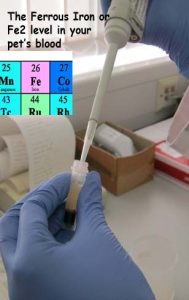Ron Hines DVM PhD
 See What Normal Blood & Urine Values Are
See What Normal Blood & Urine Values Are
 Causes Of Most Abnormal Blood & Urine Tests
Causes Of Most Abnormal Blood & Urine Tests
The Iron Content Of Your Pet’s Blood Serum = Fe
Iron is an essential ingredient in the hemoglobin that delivers oxygen to cells throughout your pet’s body. It is stored in your pet’s liver, bone marrow and spleen and found in muscle cells (in myoglobin) as well.
Reasons Why Your Pet’s Serum Iron Levels Might Be Low (hypoferremia):
Iron levels have normal moderate fluctuations in normal cats and dogs.
Intestinal parasitism – particularly in young pets, persistent anemia from any cause and substantial hemorrhage can all lower serum iron content.
Chronic intestinal inflammation, deficient amounts of iron in the pet’s diet and Iron-deficient homemade nursing formulas for infant pets can cause low iron blood readings.
Hypothyroidism, various chronic illnesses and inflammatory conditions that shift iron reserves from active blood hemoglobin and lock it into tissue macrophage cells have the potential to cause low serum iron.
Defects in your pet’s liver’s blood circulation (portosystemic shunts) and NSAID medications (such as Rimadyl® and aspirin) – probably due to their occasional ability to cause intestinal bleeding – can cause low serum iron levels.
Liver and kidney damage, antacids given over long periods of time, chronic heart disease and perhaps some interaction with oral antibiotics (quinolones and tetracycline) sometimes lower serum iron.
Reasons Why Your Pet’s Iron Levels Might Be High (hyperferremia):
Because blood levels of iron in your pet fluctuate; moderate changes do not always indicate a problem.
But overdoses of iron-containing (ferrous sulfate) vitamin/mineral supplements, sudden liver damage that releases stored iron, excessive blood loss, hemolytic anemias and bone marrow disorders have all been associated with high serum iron levels.
Complementary Tests:
Blood iron levels can fluctuate from day to day – probably as a result of changes in your pet’s cortisol levels. If the test results are out-of-step with other lab results and not in keeping with the symptoms your pet is experiencing, repeat the test in a week.
Examination of stool sample for parasites, CBC/ WBC and blood chemistry values including PCV, MCV and MCHC. Reticulocyte count and the presence of variable red blood cell size (anisocytosis). blood folate, B12 and ferritin levels, Secondary tests based on their results.
Iron concentrations are also known to have daily level swings in dogs, with concentrations being lower in the morning – this is associated with daily dips in their own (endogenous) cortisol levels. If this is true in cats as well is unknown.
DxMe
You are on the Vetspace animal health website
Visiting the products that you see displayed on this website help pay the cost of keeping these articles on the Internet.


